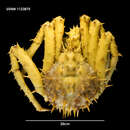pt-BR
nomes no trilho de navegação


"Lithodes couesi, new species
This species reminds one of L. maia. The largest spines of the carapace are arranged about the margin; they are slender and sharp. The longest are situated at the outer orbital angles, the antennal angles, the hepatic regions, and three on the margin of the branchial regions. The spines on the intervening spaces of the margin are more numerous and much smaller. The surface of the carapace is set with short, sharp, conical spines. The gastric region is swollen and well defined. The cardiac region is barely indicated between the confluent branchial regions. The depression between the gastric and cardiac regions is very deep. The rostrum is 20 mm. long, and made up as in L. maia, but the terminal portion beyond the distal lateral branches is slender and bifid rather than bifurcate, as in L. maia; the basal branches are a little further forward. The scale is rudimentary; the spine at the outer angle is branched at the base, the branch consisting of a single short, sharp spine on the outer surface. The abdomen is without spines; the spines of L. maia are replaced by tubercles; those of the first segment are very much closer together than the corresponding spines in L. maia. The tubercles on the lower margin of the second segment are low and somewhat oblong at base; those in the center of the segment, are larger.
The chelipeds are slender and weak. The armature of the fingers of the right hand is slight; the fingers gape. The fingers of the left hand are long and slender and gape at base. The spines of the chelipeds and ambulatory legs are numerous and arranged about as in L. maia, but are shorter.
Locality and type.—At station 3329, in 399 fathoms, north of Unalaska, a single male (No. 18531, U.S.N.M.) was taken; also at station 3338, off Shumagin Bank, in 625 fathoms, three young specimens (No. 18532, U.S.N.M.) which I refer to this species without hesitation. The rostrum differs in being bifurcate as in L. maia. It is possible that additional specimens of the adult form might show the rostrum to be bifurcate rather than bifid."
(Benedict, 1894)
Neolithodes diomedeae is a species of king crab which is found in the eastern Pacific Ocean, the southwestern Atlantic Ocean, and the Bellingshausen and Scotia Seas in the Southern Ocean.[2][3][4][5][6]
Neolithodes diomedeae are opportunistic, necrophagous scavengers.[3][7] In the Gulf of California's abyssal plain, they live around hydrothermal vents and feed on organic material which falls from the pelagic zone.[3] In deep-sea sedimentary habitats, young N. diomedeae have been found to have a symbiotic relationship with sea cucumbers, frequently situating themselves on or underneath members of the genus Scotoplanes. This relationship is hypothesized to be related to elevated food availability and shelter from predation.[8]
{{cite journal}}: CS1 maint: url-status (link) Neolithodes diomedeae is a species of king crab which is found in the eastern Pacific Ocean, the southwestern Atlantic Ocean, and the Bellingshausen and Scotia Seas in the Southern Ocean.
Neolithodes diomedeae is een tienpotigensoort uit de familie van de Lithodidae.[1] De wetenschappelijke naam van de soort is voor het eerst geldig gepubliceerd in 1895 door Benedict.
Bronnen, noten en/of referenties